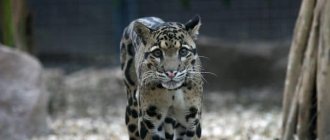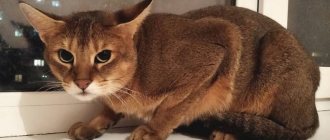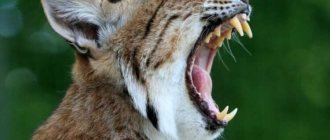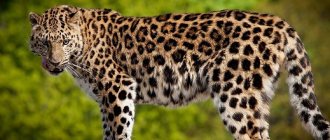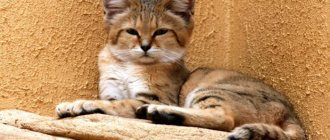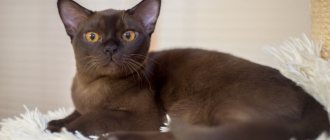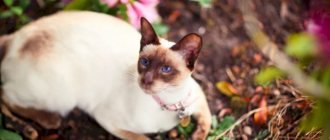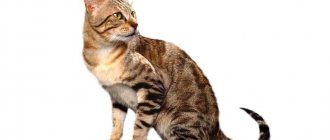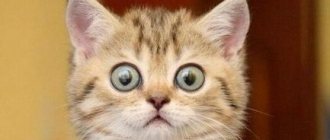1767
1768
1769
1770
1771
1772
1773
1774
1775
1776
1777
1778
1779
1780
1781
1782
1783
1784
1785
1786
1787
1788
1789
The clouded leopard (Neofelis nebulosa) is listed as vulnerable on the IUCN Red List of Threatened Species.
Clouded leopard video
In the qualifying generic list, the animal does not belong to any genus. As a species with similar features, it was included in the same genus with the marbled feline and the tiger. The clouded leopard is a kind of “transition” from the impressive size of predators and smaller cats living in nature. And more recently, this amazing cat is classified in the same genus as the tiger.
The jungle is the home of the clouded leopard, which stretches from lowlands to mountain passes. The maximum point where the predator was encountered was 2.5 kilometers above sea level. It has even been seen in the Tibetan mountain ranges. Being an excellent tree climber, the clouded leopard actually does not leave the upper tiers of the jungle. They serve him not only as a place to sleep and rest, but also as an ambush in which the animal awaits its prey.
This animal is very difficult to see. He lives in places that are practically inaccessible to humans. The color of the “fur coat” allows the predator to become almost invisible in the lush greenery of the jungle. The clouded leopard is an agile predator capable of moving along branches in the upper tiers of the jungle. The danger that awaits the cat is the intensive destruction of the forests of China and southeast Asia, the animal’s natural habitat.
Links[edit]
- ^ abcdefg Hearn, A.; Ross, J.; Brodie, J.; Cheyne, S.; Haidir, I.A.; Loken, B.; Mathai, J.; Wilting, A., McCarthy, J. (2016). "Neofelis diardi". IUCN Red List of Threatened Species
.
2016
: e.T136603A97212874. - ^ abc Buckley-Beason, Virginia; Johnson, WE; Nash, W. G.; Stanyon, R.; Menninger, J.C.; Driscoll, California; Howard, J.; Bush, M.; Page, J.E.; Roelke, M.E.; Stone, G.; Martelli, P.; Wen, C.; Ling, L.; Duraisingam, RK; Lam, W. P., & O'Brien, S. J. (2006). "Molecular evidence for species-level differences in clouded leopards". Current Biology
.
16
(23):2371–2376. DOI: 10.1016/j.cub.2006.08.066. PMC 5618441. PMID 17141620. - ^ a b c d Kitchener, AC; Beaumont, M. A., Richardson, D. (2006). "Geographical Variation in the Clouded Leopard, Neofelis nebulosa
, Reveals Two Species."
Current Biology
.
16
(23):2377–2383. DOI: 10.1016/j.cub.2006.10.066. PMID 17141621. S2CID 6838593. - Kitchener, A.C.; Breitenmoser-Würsten, C.; Eizirik, E.; Gentry, A.; Werdelin, L.; Wilting, A.; Yamaguchi, N.; Abramov, A.V.; Christiansen, P.; Driscoll, C.; Duckworth, J. W.; Johnson, W.; Luo, S.-J.; Meijaard, E.; O'Donoghue, P.; Sanderson, J.; Seymour, K.; Bruford, M.; Groves, C.; Hoffmann, M.; Nowell, K.; Timmons, Z., & Tobe, S. (2017). "Revised Taxonomy of Felids: Final Report of the IUCN Cat Classification Task Force of the IUCN Cat Specialist Group" (PDF). Cat News
(Special Issue 11): 65-66. - Sunquist, F. & Sunquist, M. (2014). "Miscled Leopard". The Wildcat Book: Everything You Ever Wanted to Know About Cats
. Chicago: University of Chicago Press. paragraphs 61−68. ISBN 978-0-2261-4576-1. - Beolens, B.; Watkins, M., & Grayson, M. (2009). "Diard". Dictionary of Mammal Eponyms
. Baltimore: Johns Hopkins University Press. paragraph 110. ISBN 978-0-8018-9533-3. - Guggisberg, C. A. W. (1975). "Clouded leopard Neofelis nebulosa
(Griffiths, 1821)."
Wild cats of the World
. New York: Taplinger Publishing. pp. 125–130. ISBN 978-0-8008-8324-9. - Wilting, A.; Fischer, F.; Abu Bakar, S. and Linsenmayr, K.E. (2006). "Clouded leopards, secretive top predators of Southeast Asian rainforests: their distribution, status and conservation needs in Sabah, Malaysia". BMC Ecology
.
6
: 16. DOI: 10.1186/1472-6785-6-16. PMC 1654139. PMID 17092347. - Wilting, A.; Mohamed, A.; Ambu, L.N.; Lagan, P.; Mannan, S.; Hofer, H., & Sollman, R. (2012). "Density of the vulnerable leopard seal Neofelis diardi in two commercial forest reserves in Sabah, Malaysian Borneo". Oryx
.
46
(3):423–426. DOI: 10.1017/S0030605311001694. - Jump up
↑ Holden, J. (2001).
"Small cats in Kerinci Seblat National Park, Sumatra, Indonesia: evidence collected from camera traps." Cat News
(35): 11–14. - Pusparini, W.; Wibisono, H. T.; Reddy, G.V.; Tarmizi; Bharata, P. (2014). "Small and medium-sized cats in Gunung Leuser National Park, Sumatra, Indonesia." Cat News
(Special Issue 8): 4–9. - McCarthy, J.L.; Wibisono, H. T.; McCarthy, K.P.; Fuller, T.K.; Andayani, N. (2015). "Assessing the distribution and habitat use of four species of felids in Bukit Barisan Selatan National Park, Sumatra, Indonesia". Global Ecology and Conservation 3
.
3
: 210-221. DOI: 10.1016/j.gecco.2014.11.009. - Hutujulu, B.; Sunarto; Klenzendorf, S.; Supriatna, J.; Budiman, A.; Yahya, A. (2007). "A Study on the Ecological Characteristics of the Clouded Leopard in Riau, Sumatra." In J. Hughes; M. Mercer (ed.). Felid biology and conservation: program and abstracts. International Conference, 17–20 September 2007, Oxford
. Oxford: University of Oxford, Wildlife Conservation Research Unit. pp. 17−21. - Meijaard, E. (2004). "Biogeographic history of the Javan leopard Panthera pardus based on craniometric analysis". Journal of Mammology
.
85
(2):302–310. DOI: 10.1644/BER-010. - Cuvier, G. (1823). "Des ossemens des grands felis". Recherches sur les ossemens fossiles: où l'on rétablit les caractères de plusieurs animaux dont les révolutions du global ont détruit les espèces. Volume IV: Fossils Les ruminans et les carnassiers
. Paris: J. Dufour and E. d'Aucagne. pp. 407−456. - Pocock, R.I. (1917). "Classification of extant felids". Annals and Journal of Natural History: Including Zoology, Botany and Geology
.
8th. 20
(119): 329–350. DOI: 10.1080/00222931709487018. - ^ ab Wilting A.; Christiansen P.; Kitchener AC; Kemp YJM; Ambu L.; Fickel, J. (2010). "Geographical changes and evolutionary history of the Sunda clouded leopard (Neofelis diardi) (Mammalia: Carnivora: Felidae) with description of a new subspecies from Borneo". Molecular phylogenetics and evolution
.
58
(2):317–328. DOI: 10.1016/j.ympev.2010.11.007. PMID 21074625. - Gavoa, D.L.A.; Wandonoc, H.; Setiabudid, F. (2007). “Three decades of deforestation in southwest Sumatra: have protected areas stopped logging and deforestation and encouraged regrowth?” (PDF). Biological conservation
.
134
(4):495–504. DOI: 10.1016/j.biocon.2006.08.035. - Rautner, M.; Hardiono, M.; Alfred, R.J. (2005), Borneo: Treasure Island in Danger. State of Forests, Wildlife and Related Threats on the Island of Borneo (PDF), WWF Germany
- Povey, K.; Sunarto, H. J. G.; Priatna, D.; Ngoprasert, D.; Reed, D.; Wilting, A.; Lynam, A.; Haidai, I.; Long, B.; Johnson, A.; Cheyne, S.; Breitenmoser, C.; Holzer, K.; Byers, O. CBSG., ed. (2009), Clouded Leopard and Small Felids Conservation Summit Final Report (PDF), IUCN/SSC Conservation Breeding Specialist Group: Apple Valley, MN.
- Shahminan F., Begawan, B. S. (2010). Poaching threatens clouded leopards. Archived May 8, 2013, at the Wayback Machine The Brunei Times, December 19, 2010
- Hearn, A.; Ross, J. (2006). "Bornean Wildcat and Clouded Leopard" (PDF). Cat Project of the Month - November 2006 IUCN/SSC Cat Specialist Group
. - Wilting, A.; Mohamed, A. (2009). "Implications of different forest management strategies for felids in Sabah, Malaysia" (PDF). Cat Project of the Month - May 2009 IUCN/SSC Cat Specialist Group
. - Liddell, H. G.; Scott, R. (1889). "νεοs". Intermediate Greek-English Lexicon
. Oxford: Clarendon Press. - Lewis, Connecticut (1890). "pheles or faeles". An Elementary Latin Dictionary
. New York, Cincinnati and Chicago: American Book Company. - Horsfield, T. (1825). "Rimau-Dahan's Description of the Sumatra Inhabitants, a New Species of Felis Discovered in the Forests of Bencoolen by Sir Thomas Stamford Raffles, Late Lieutenant-Governor of Fort Marlborough". Zoological Journal of London 1
: 542–554. - "Missed leopards spotted on Mount Santubong". Borneo Post. April 6, 2014. Retrieved January 10, 2021.
What does a clouded leopard eat?
The clouded leopard is a carnivore whose diet consists of jungle primates and birds. The cat catches and kills its prey only with a powerful blow of its paw, being high above the ground, in the branches of trees. Natural camouflage allows the predator to sneak up close to the prey, remaining unnoticed against the background of foliage.
The clouded leopard hunts not only in trees. On land, goats, pigs and deer can be its victims. No matter how heavy the prey, the predator easily and without fear of falling jumps onto a tree and only there begins to eat. With game in its mouth, the clouded leopard is able to maintain its balance while standing on its two hind legs.
Very often, deforestation forces the predator to attack livestock. Although he usually tries to avoid places inhabited by people. Not only the clouded leopard inhabits the expanses of the jungle, tigers and panthers, which are stronger and larger, also live there. Therefore, in the event of a collision, the clouded leopard prefers to leave, since it knows that it will lose. For a very long time it was thought that the predator was exclusively nocturnal, but now the inconsistency of the bottom statement has been reliably documented. He hunts not only at sunset, when his potential prey is sleeping, but also during the day.
Appearance of the animal
In length, male clouded leopards reach 80-105 centimeters, and females - 68-95 centimeters. To this figure it is also worth adding the length of the tail - 60-90 centimeters. The height at the withers is about 50-55 centimeters. Clouded leopards weigh 11-23 kilograms.
This wild cat has luxurious fur.
The animal has short and wide limbs, with the hind legs being longer than the front ones. The head shape is elongated. The fangs are large.
The eyes are yellow. The skin is dark ocher or dark gray with dark gray or black spots. The spots are large, their shape is not the same.
There are also spots on the head. Black stripes stretch from the corners of the eyes to the mouth. The spots along the spine are elongated. There are also spots on the stomach and legs. The tail is surrounded by black half rings.
Clouded leopards are night hunters.
Clouded leopard cubs
Due to the fact that the clouded leopard lives in hard-to-reach places, there is very little information about its mating games and reproduction. It is known that in zoos the birth of kittens occurs in the spring months. Usually a female gives birth to 2 blind kittens, but sometimes there are 5 babies in a litter. The weight of the kittens is negligible, only 150 grams, they are blind and practically motionless. They begin to see after two weeks, and on the 35th day of life they actively move around the den. For 70 days, the mother feeds the clouded leopard kittens only milk, without adding meat to the babies’ diet.
At the age of five months, kittens begin to slowly eat meat that the mother brings from the hunt. Grown-up babies gain complete independence only at the age of nine months, but before this time they must learn the hunting craft and adopt all the skills from their mother when she takes them hunting with her. Games play an important role, in which clouded leopard kittens spend most of their time. They help not only to fully develop and build much-needed muscle mass, but also provide initial hunting skills. The fur of kittens is monochromatic until they are six months old, and only with age do they develop characteristic patterns, like those of adults.
Literature
- Christiansen, Per: Species distinction and evolutionary differences in the clouded leopard (Neofelis nebulosa) and Diard's clouded leopard
.
In: Journal of Mammalogy December 2008: Bd.
89 , Ausgabe 6, pp. 1435–1446. - Kitchener, A. et al. (5. December 2006): Geographical Variation in the Clouded Leopard, Neofelis nebulosa, Reveals Two Species
.
In: Current Biology 16 (23)
, S. 2377–2383. - Sunquist, M.E. & F.C.: Family Felidae (Cats)
In: Don E. Wilson & Russel Mittermeier (Hrsg.)
Handbook of the Mammals of the World Volume 1: Carnivores
. Lynx Editions. 2009. S. 127. ISBN 978-84-96553-49-1
Top Articles: These Little Sticky Leaves Are a Deadly Insect Trap
Clouded leopard and people
The man began to sound the alarm when the clouded leopard was on the verge of extinction. Having no prohibitions, in the last century, people did not hesitate to exterminate the animal, solely because of its elegant skin. Poachers still trade, despising the laws, with hats made from the fur of a predator.
People noticed the likelihood of extinction of the species when they came to its sought-after lands for valuable wood raw materials. Almost the entire habitat was destroyed, including the most inaccessible corners. The clouded leopard never inspired fear among the aborigines, like the tiger, but this did not stop it from being destroyed, since occasionally poultry fell into its paws.
Content Features
A clouded leopard as a pet is very rare. An active animal requires a spacious enclosure, well equipped and occupying a fairly large area. Reproduction in captivity occurs very rarely.
Smoky individuals are purchased from specialized nurseries that breed predators in captivity. The price for a cute wild cat starts at $25 thousand. In addition, it will take an impressive amount of money to feed her pussy every day, because she will not eat anything other than meat and fish dishes.
The purchase of a clouded leopard pays off only if it is placed in a zoo, where the price of a ticket and the huge number of visitors make it possible to provide the wild predator with everything it needs.
Where does the clouded leopard live?
The lands of India and Nepal, to the east, passing the Himalaya mountain range to the southern regions of China, the eastern territories of Asia, spreading to the south, on the islands of Sumatra, Java and Kalimantan, including the impenetrable corners of Taiwan, lives an amazing and elusive predator.
Clouded leopard conservation
The clouded leopard has practically disappeared as a species and, of course, is now under international protection, including the Washington Convention (CITES).
Behavior
The animal leads an active lifestyle around the clock. It can hunt even during the day, but prefers the night time. The leopard swims well and moves along horizontal branches. At the same time, it can lower its head down and hang on a branch like a sloth.
The animal lives alone, except for the mating season. The area occupied by one individual can reach 45 square kilometers.
